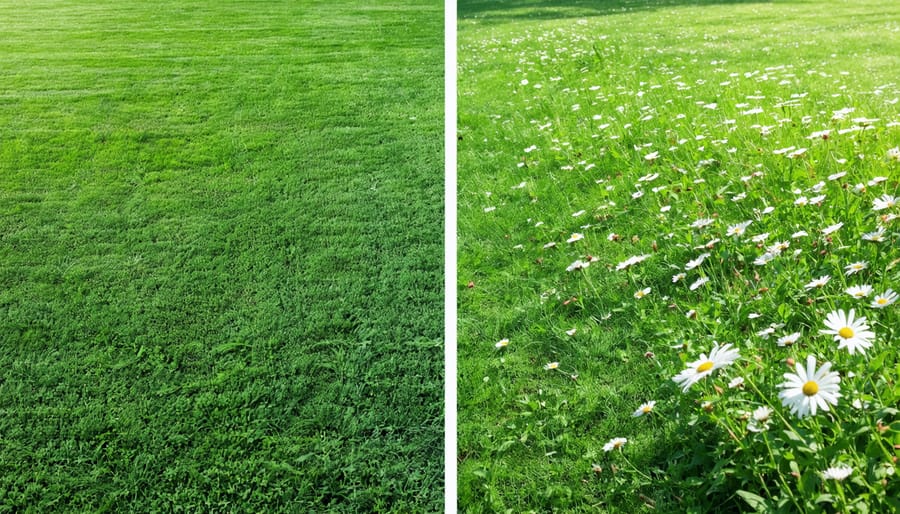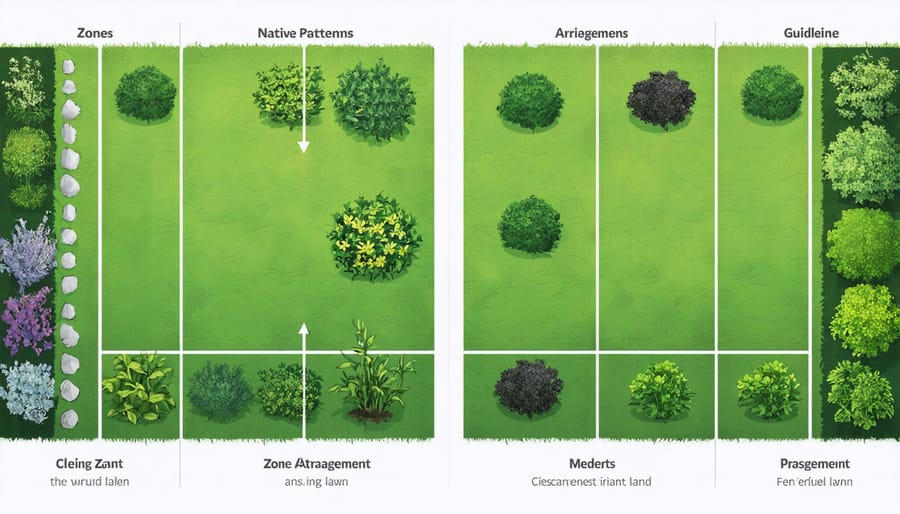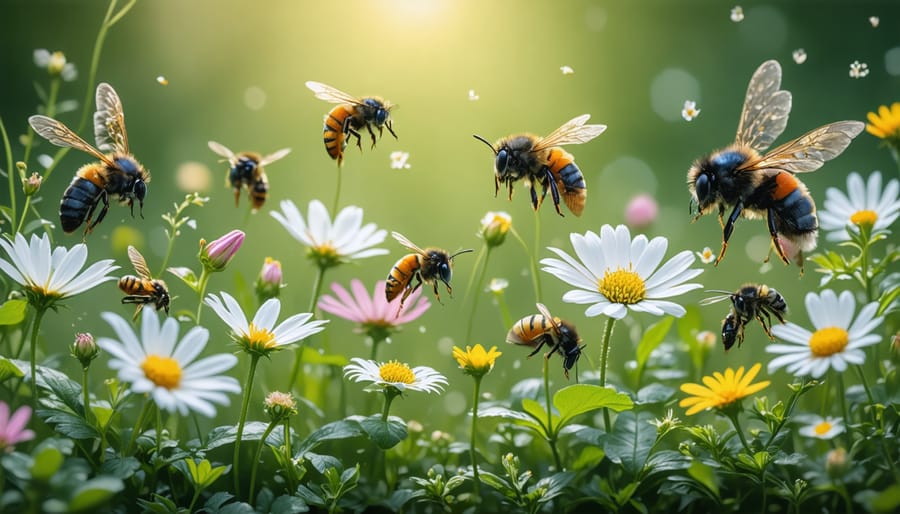Transform your traditional lawn into a vibrant, living ecosystem by replacing uniform grass with diverse native plants, flowering perennials, and beneficial groundcovers. This modern approach to eco-friendly landscaping alternatives creates a stunning, low-maintenance yard that supports local wildlife while reducing water consumption and chemical inputs.
Picture a dynamic outdoor space where butterflies dance between clusters of wildflowers, beneficial insects patrol for garden pests, and birds feast on native berries. Beyond its natural beauty, a biodiversity lawn cuts maintenance costs by up to 50%, eliminates the need for synthetic fertilizers, and provides year-round visual interest through changing seasons.
Unlike conventional turf that acts as a green desert, biodiversity lawns function as miniature nature preserves, offering food and shelter for pollinators while naturally filtering rainwater and preventing soil erosion. This practical approach to sustainable landscaping proves that environmental responsibility and stunning curb appeal can flourish together in your own backyard.
Why Traditional Lawns Are Becoming Obsolete
The Hidden Costs of Perfect Green Lawns
That picture-perfect green lawn comes with a hefty price tag – both for your wallet and the environment. Traditional lawns typically require weekly mowing, regular watering, and frequent applications of fertilizers and pesticides. The Environmental Protection Agency estimates that lawn care equipment accounts for 5% of U.S. air pollution, while excessive water usage for lawn maintenance strains local resources, especially during drought seasons.
The financial burden is equally significant. Between water bills, chemical treatments, and equipment maintenance, maintaining a conventional lawn costs American homeowners an average of $500-$800 annually. Not to mention the hours spent on weekly maintenance that could be better invested elsewhere.
This is why many homeowners are turning to climate-ready landscaping solutions that work with nature rather than against it. By embracing biodiversity in our yards, we can create beautiful outdoor spaces that require less maintenance, use fewer resources, and support local wildlife – all while keeping more money in our pockets.

Benefits of Biodiversity-Rich Yards
A biodiversity-rich yard offers far more than just visual appeal – it’s a thriving ecosystem that benefits both wildlife and homeowners alike. By transforming your traditional lawn into a diverse landscape, you create essential habitats for local birds, beneficial insects, and small mammals that help maintain natural pest control.
Pollinators like bees, butterflies, and hummingbirds particularly thrive in these environments, ensuring better fruit and vegetable yields if you have a garden. These natural visitors not only enhance your outdoor experience but also play a crucial role in maintaining the health of your entire yard.
For homeowners, the advantages are equally impressive. Biodiversity-rich yards typically require less water and maintenance than traditional lawns, leading to lower utility bills and fewer hours spent mowing. They’re also more resilient to drought and disease, as different plant species support each other’s growth and survival.
The natural beauty of a diverse yard changes with the seasons, providing year-round visual interest and creating a unique outdoor space that stands out in your neighborhood. Plus, you’ll have the satisfaction of knowing you’re contributing to local ecosystem health while creating a sustainable, low-maintenance landscape.
Creating Your Biodiversity Lawn
Selecting Native Plants and Grasses
When it comes to choosing native plants for your biodiversity lawn, think of yourself as a matchmaker between your yard and local flora. Start by researching what naturally grows in your region – these plants have already mastered thriving in your specific climate and soil conditions.
Look for a mix of different heights and growth patterns to create various layers in your lawn. Consider low-growing ground covers like wild strawberry or creeping thyme, mid-height plants such as native fescues or sedges, and taller flowering species that add splashes of color and attract pollinators.
Your local extension office or native plant society can be incredibly helpful resources. They often maintain lists of region-specific plants and can recommend species that work well together. When selecting your mix, aim for:
• At least 3-5 different grass species for structural diversity
• Several flowering plants that bloom at different times
• Ground covers that help prevent soil erosion
• Plants that support local wildlife and insects
Don’t forget to consider your yard’s specific conditions. Note sunny and shady areas, soil moisture levels, and any slopes or low spots. These microenvironments in your yard create opportunities for different plant communities to thrive.
Remember to start small and expand gradually. You might begin with a test patch using 5-7 species and observe how they interact. This approach helps you learn what works best in your space while building confidence in managing your biodiversity lawn.
Design Principles for Natural Flow
Creating a naturally flowing biodiversity lawn starts with thoughtful design that mimics nature’s patterns. Begin by mapping your yard’s natural contours and identifying areas that receive different amounts of sunlight. These variations will help you create distinct microhabitats that support diverse plant species.
Instead of planting in rigid rows, arrange your plants in gentle curves and clusters. This approach not only looks more natural but also helps beneficial insects and pollinators move easily through your space. Consider creating meandering pathways that guide visitors through your biodiverse landscape while providing opportunities to observe different plant communities up close.
Layer your plantings by height, with taller species at the back or center of beds, medium-height plants in the middle, and ground covers at the edges. This creates visual interest and provides various habitats for wildlife. Leave some open spaces between plant groupings to allow for natural spread and self-seeding, which will help your lawn evolve organically over time.
Include focal points like large ornamental grasses or flowering perennials to draw the eye through the landscape. These anchor points can help tie different areas together while maintaining visual harmony. Consider incorporating natural elements like logs, rocks, or small water features to add texture and create additional microhabitats.
Remember to work with your yard’s existing features rather than against them. If you have a naturally damp area, embrace it by choosing moisture-loving plants. Similarly, use drought-resistant species in sunny, dry spots. This approach not only creates a more successful garden but also requires less maintenance over time.

Installation and Initial Care
Creating a biodiversity lawn starts with proper planning and preparation. Begin by selecting the right time – early spring or fall are ideal seasons when temperatures are mild and rainfall is more frequent. First, assess your existing lawn and remove any invasive weeds that might compete with your desired plant species.
Before planting, prepare your soil by removing about 2-3 inches of the existing turf if needed. Loosen the soil with a garden fork and incorporate organic matter to improve soil structure. This creates an ideal environment for diverse plant species to thrive.
Choose a seed mix that includes native grasses, flowering perennials, and low-growing plants suitable for your climate zone. Many suppliers offer pre-mixed biodiversity lawn seed blends, or you can create your custom mix. Aim for at least 10-15 different species to ensure true biodiversity.
Sow the seeds evenly across your prepared area using a seed spreader or by hand. Rake the area lightly to ensure good seed-to-soil contact, but avoid burying the seeds too deeply. Water the newly seeded area thoroughly but gently to avoid washing away the seeds.
During the first few weeks, keep the soil consistently moist but not waterlogged. Water lightly twice daily in dry weather until germination occurs. Once seedlings emerge, reduce watering frequency but increase the amount per session to encourage deep root growth.
Initially, your biodiversity lawn might look a bit sparse – this is normal! Be patient, as different species germinate at various rates. Some plants may take several weeks to appear. Avoid mowing until the new plants are at least 4 inches tall, typically about 4-6 weeks after sowing.
Pro tip: Consider starting with a small test area if you’re new to biodiversity lawns. This allows you to learn from experience and adjust your approach before tackling larger spaces.
Maintaining Your Living Landscape

Seasonal Care Calendar
Maintaining a biodiversity lawn requires different care throughout the year. Here’s your monthly guide to earth-friendly yard maintenance:
Spring (March-May):
– March: Remove dead plant material and overseed bare patches with native wildflower mix
– April: Light mowing (set blade high) to control aggressive species
– May: Allow spring flowers to bloom and set seed before first major cut
Summer (June-August):
– June: Mow paths while leaving flowering areas untouched
– July: Water only during extreme drought, focusing on deep root development
– August: Selective mowing of completed bloom areas, leaving 3-4 inches height
Fall (September-November):
– September: Final mowing of the season, collect clippings for composting
– October: Plant spring-flowering bulbs between existing plants
– November: Leave some areas unmowed for winter wildlife shelter
Winter (December-February):
– December: Avoid walking on frozen grass
– January: Plan next season’s additions and remove invasive species
– February: Begin clearing dead material as weather permits
Year-round tips:
– Mow only when necessary (typically 4-6 times per year)
– Leave clippings when possible to return nutrients
– Maintain dedicated paths to protect plant diversity
– Avoid chemical fertilizers and pesticides
– Document blooming patterns to improve next year’s care
Remember, flexibility is key – adjust this schedule based on your local climate and the specific needs of your biodiversity lawn.
Common Challenges and Solutions
While creating a biodiversity lawn can be rewarding, you might encounter some common challenges along the way. Don’t worry – we’ve got solutions for each one!
Uneven Growth Patterns
If you notice some areas growing faster than others, this is actually normal in biodiversity lawns. The key is to embrace these natural variations, as they create valuable micro-habitats for wildlife. Simply adjust your mowing height to accommodate the different growth rates.
Weed Management
Sometimes it can be tricky to distinguish between beneficial wildflowers and unwanted weeds. Start by learning to identify common native species in your area. Remove invasive plants by hand-pulling them when the soil is moist, and avoid using chemical herbicides that could harm beneficial species.
Initial Establishment Period
The first few months might look a bit messy as different species establish themselves. Be patient! Cover any bare patches with a light layer of compost and consider overseeding during appropriate seasons. Remember that a diverse lawn takes time to reach its full potential.
Neighbor Concerns
Some neighbors might view your biodiversity lawn as untidy. Address this by maintaining neat edges along property lines and placing decorative elements like bird baths or garden stones. Consider creating an informative yard sign explaining the environmental benefits of your approach.
Seasonal Transitions
Different plants will dominate during different seasons, which might create temporary bare spots. Plan for continuous blooming by incorporating species that peak at different times throughout the growing season. Keep a mix of early spring, summer, and fall-blooming plants to maintain consistent coverage.
These challenges are all part of the natural process of creating a thriving ecosystem in your yard. With patience and the right approach, you’ll soon have a beautiful, sustainable lawn that supports local wildlife.
Creating a biodiversity lawn is more than just a landscaping choice – it’s a meaningful step toward a more sustainable and vibrant future for your outdoor space. By transforming your traditional lawn into a thriving ecosystem, you’re not only reducing maintenance time and costs but also providing essential habitats for local wildlife, from beneficial insects to native birds.
The benefits are clear: lower water consumption, reduced mowing needs, decreased chemical usage, and a naturally beautiful yard that changes with the seasons. Your biodiversity lawn will become a living testament to environmental stewardship while requiring less work from you – a win-win situation for both nature and your weekend schedule.
Starting your biodiversity lawn journey doesn’t have to be overwhelming. Begin with a small section of your yard, gradually introducing native plants and allowing natural diversity to flourish. Remember that every step counts, whether you’re adding wildflowers, creating patches of longer grass, or incorporating local plant species.
As you watch your new ecosystem develop, you’ll discover the joy of working with nature rather than against it. Your yard will become a conversation starter, inspiring neighbors and creating a ripple effect in your community. Take that first step today – your future self, local wildlife, and the environment will thank you for embracing this sustainable approach to lawn care.
